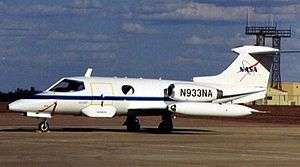Learjet 23
| Learjet 23 | |
|---|---|
 | |
| NASA Learjet 23 | |
| Role | Business jet |
| Manufacturer | Learjet |
| Designer | William Powell Lear, based on a design by Dr.eng. Hans-Luzius Studer |
| First flight | 7 October 1963 |
| Introduction | October 13, 1964 |
| Status | Active |
| Primary users | Private Military |
| Produced | 1962-1966 |
| Number built | 104 |
|
| |
The Learjet 23 is an American built six-to-eight-seat (two crew and four to six passengers) twin-engine, high-speed business jet manufactured by Learjet. Introduced in 1964, it was Learjet's first model and created a completely new market for fast and efficient business aircraft. 104 units were manufactured before production ceased just two years later in 1966.
History
William (Bill) Powell Lear, Sr. recognized the FFA P-16's potential and established Swiss American Aviation Corporation (SAAC) to produce a passenger version as the SAAC-23 Execujet. The company moved to Wichita, Kansas and was renamed as the Lear Jet Corporation, production was started on the first Model 23 Learjet on February 7, 1962. The first flight of the Learjet 23 took place on 7 October 1963 with test pilots Hank Beaird and Bob Hagen.[1] Although the prototype crashed in June 1964 the type Learjet 23 was awarded a type certificate by the Federal Aviation Administration on 31 July 1964. On October 13, 1964, the first production aircraft was delivered.
With this jet a completely new market for fast and efficient business aircraft was opened. The Model 23 was the basis for a whole set of similar aircraft which remain in production.
Production of the Learjet 23 stopped in 1966 after a total of 104 had been built. In 1998 there were still 39 Model 23s in use. A total of 27 have been lost or damaged beyond repair through accidents during the aircraft's lengthy career, the most recent in 2008.[2]
Noise compliance
In 2013, the FAA modified 14 CFR part 91 rules to prohibit the operation of jets weighing 75,000 pounds or less that are not stage 3 noise compliant after December 31, 2015. The Learjet 23 is listed explicitly in Federal Register 78 FR 39576. Any Learjet 23s that have not been modified by installing Stage 3 noise compliant engines or have not had "hushkits" installed for non-compliant engines will not be permitted to fly in the contiguous 48 states after December 31, 2015, and the rule points out that appropriate hushkits are not currently available for the Learjet 23. 14 CFR §91.883 Special flight authorizations for jet airplanes weighing 75,000 pounds or less - lists special flight authorizations that may be granted for operation after December 31, 2015.
Aircraft on display
- 23-002 – Model 23 on static display at the Udvar-Hazy Center of the National Air and Space Museum in Chantilly, Virginia.[3][4]
- 23-006 – Model 23 on static display at the Kansas Aviation Museum in Wichita, Kansas.[5][4]
- 23-009 – Model 23 on display at the Arkansas Air & Military Museum in Fayetteville, Arkansas. This airframe was flown by Bobby Younkin in air shows.[6][7]
- 23-015 – Model 23 on static display at the Pima Air & Space Museum in Tucson, Arizona.[8]
- 23-034 – Model 23 on static display at the Museum of Flight in Seattle, Washington.[9]
- 23-068 – Model 23 in storage at the Yanks Air Museum in Chino, California.[10]
Operators
Specifications
Data from Jane's All The World's Aircraft 1965–66[11]
General characteristics
- Crew: Two pilots
- Capacity: 6 passengers
- Length: 43 ft 3 in (13.18 m)
- Wingspan: 35 ft 7 in (10.84 m)
- Height: 12 ft 7 in (3.84 m)
- Wing area: 231.1 ft² (21.48 m²)
- Empty weight: 6,150 lb (2,790 kg)
- Max. takeoff weight: 12,499 lb (5,670 kg)
- Powerplant: 2 × General Electric CJ610-4 turbojets, 2,850 lbf (12.71 kN) each
Performance
- Maximum speed: 561 mph (488 knots, 903 km/h, Mach 0.82) at 24,000 ft (7,300 m)
- Cruise speed: 518 mph (450 knots, 834 km/h) at 40,000 ft (12,200 m)
- Stall speed: 104 mph (90 knots, 168 km/h) (wheels and flaps down)
- Range: 1,830 mi (1,591 nmi, 2,945 km) (max fuel at 485 mph (780 km/h) and 40,000 ft (12,200 m)
- Service ceiling: 45,000 ft (13,715 m)
- Rate of climb: 6,900 ft/min (35 m/s)
See also
- Related lists
References
- ↑ Flying Magazine: 38. December 1993. Missing or empty
|title=(help) - ↑ Aviation Safety Network: Learjet 23
- ↑ "Lear Jet 23". Smithsonian National Air and Space Museum. Smithsonian Institution. Retrieved 8 November 2016.
- 1 2 "Learjet 23/24 production list". rzjets. rzjets.net. Retrieved 8 November 2016.
- ↑ "Learjet Model 23". Kansas Aviation Museum. Retrieved 8 November 2016.
- ↑ Mathews, Kay (4 February 2011). "Since 1986 aviation history flies high at the Arkansas Air Museum". Digital Journal. digitaljournal.com. Retrieved 8 November 2016.
- ↑ "Aircraft N23BY Data". Airport-Data.com. Airport-Data.com. Retrieved 8 November 2016.
- ↑ "LEARJET MODEL 23". Pima Air & Space Museum. Pimaair.org. Retrieved 8 November 2016.
- ↑ "Learjet 23". The Museum of Flight. The Museum Of Flight. Retrieved 8 November 2016.
- ↑ "Airframe Dossier - Swiss American Aviation CorporationLearjet, c/n 23-068, c/r N73CE". Aerial Visuals. AerialVisuals.ca. Retrieved 8 November 2016.
- ↑ Talyor 1965, pp. 252–253.
- Ogden, Bob, "Aviation Museums and Collections of North America", 2007, Air-Britain (Historians) Ltd, ISBN 0-85130-385-4.
- Taylor, John W. R. Jane's All The World's Aircraft 1965–1966. London:Sampson Low, Marston & Company, 1965.
- Specs of the Learjet Model 23
- Learjet timeline from Wings of Kansas
External links
| Wikimedia Commons has media related to Learjet 23. |